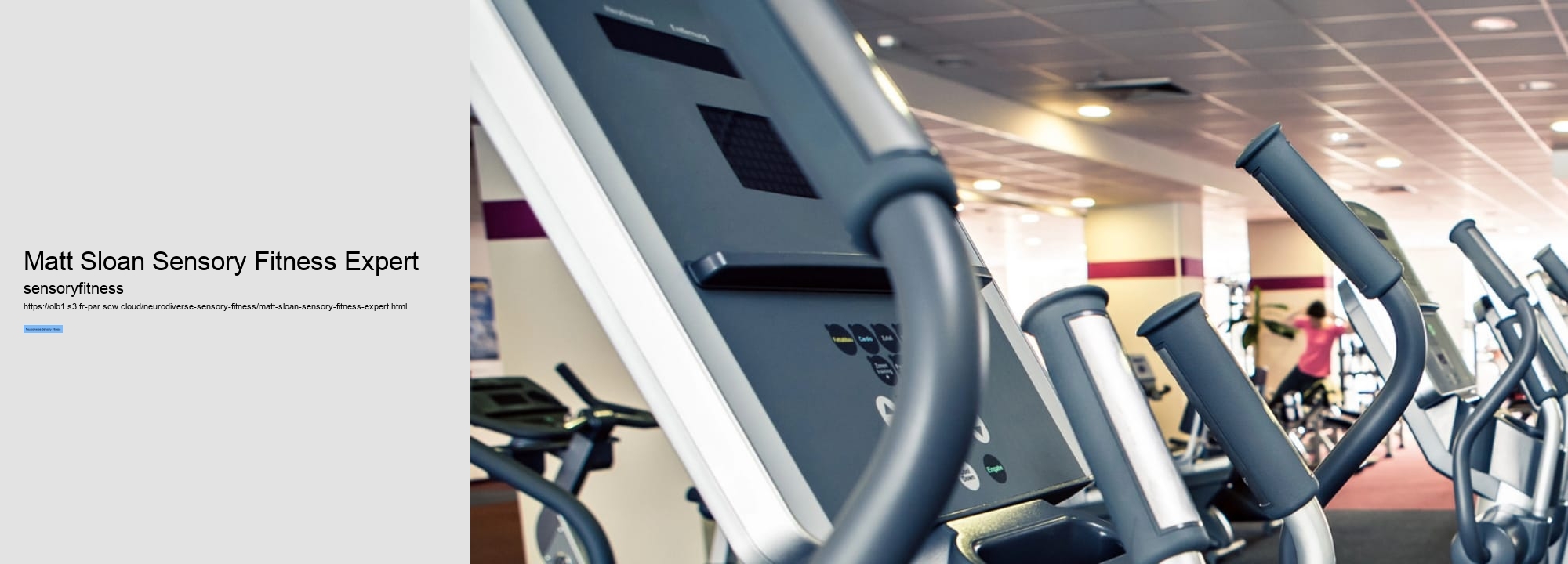

Neurodiverse individuals may benefit from choosing music that is calming or energizing based on their individual preferences. Visual stimuli can also play a key role in enhancing sensory experiences during workouts. Incorporating colorful visuals or patterns into the workout space can help individuals stay focused and engaged throughout their exercise routine.
These techniques can help neurodiverse individuals stay present and connected to their bodies while exercising. Overall, incorporating sensory activities into workouts for neurodiverse individuals can enhance the overall exercise experience by providing additional stimulation, relaxation, and focus.
How to tailor fitness programs to accommodate different sensory needs in neurodiverse individualsWhen it comes to creating fitness programs for neurodiverse individuals, it is important to consider their unique sensory needs. Neurodiversity encompasses a range of conditions such as autism, ADHD, and sensory processing disorder, which can impact how a person experiences the world around them.
By tailoring fitness programs to accommodate these sensory needs, we can create an inclusive and supportive environment that promotes physical health and well-being. One key consideration when designing fitness programs for neurodiverse individuals is to provide options for different sensory preferences. For example, some individuals may be sensitive to loud noises or bright lights, while others may seek out deep pressure or proprioceptive input. By offering a variety of equipment and exercises that cater to these preferences, we can ensure that everyone feels comfortable and engaged during their workout. In addition to sensory preferences, it is also important to consider individual differences in motor skills and coordination. Some neurodiverse individuals may have challenges with balance or coordination, which can impact their ability to participate in certain types of exercises.
Another important aspect of accommodating sensory needs in neurodiverse individuals is creating a safe and predictable environment. This may involve setting clear expectations for behavior, providing visual schedules or cues, and offering opportunities for breaks or downtime as needed. By establishing a routine and structure that supports each individual's sensory needs, we can help them feel more comfortable and confident in their fitness program. Overall, tailoring fitness programs to accommodate different sensory needs in neurodiverse individuals requires creativity, flexibility, and empathy. By taking the time to understand each person's unique preferences and challenges, we can create an inclusive environment where everyone has the opportunity to thrive physically and emotionally.
How to use adaptive equipment to enhance sensory fitness for neurodiverse individualsAdaptive equipment can play a crucial role in enhancing sensory fitness for neurodiverse individuals. By utilizing specialized tools and devices, we can create a more inclusive environment that supports the unique sensory needs of those with conditions such as autism, ADHD, or sensory processing disorder. One key aspect of using adaptive equipment is to understand the specific sensory challenges faced by each individual. For example, some people may be hypersensitive to certain stimuli, while others may seek out additional sensory input to feel regulated. By identifying these preferences and aversions, we can tailor our use of adaptive equipment to provide the right kind of sensory input.
Weighted blankets or vests, for instance, can provide deep pressure stimulation that helps calm an overstimulated nervous system. Fidget toys and chewable jewelry can offer oral sensory input for those who seek out opportunities for mouthing and chewing. Sensory swings or rocking chairs can provide vestibular input that promotes balance and coordination. When using adaptive equipment, it's important to introduce it gradually and allow individuals time to acclimate to the new sensations. Encourage them to explore different tools and find what works best for them in different environments or situations.
Consistency is key in building a routine that supports their sensory needs. Incorporating adaptive equipment into daily routines can help neurodiverse individuals regulate their senses and improve their overall well-being. Whether at home, school, or in community settings, providing access to these tools can empower individuals to better navigate their environment and engage in activities that bring them joy. By recognizing the importance of adaptive equipment in enhancing sensory fitness for neurodiverse individuals, we can create a more inclusive society where everyone has the support they need to thrive. Let's continue exploring innovative ways to utilize these tools and promote greater understanding and acceptance of neurodiversity. How to make exercise more enjoyable and engaging for neurodiverse individuals through sensory integrationExercise is a crucial component of overall health and well-being for everyone, including neurodiverse individuals.
This can make it challenging to stay motivated and consistent with a fitness routine. One way to make exercise more enjoyable and engaging for neurodiverse individuals is through sensory integration. Sensory integration involves incorporating activities that stimulate the senses in order to improve focus, coordination, and overall physical wellness. By tailoring exercise routines to include sensory-rich experiences, individuals with sensory processing differences can better connect with their bodies and find pleasure in movement. There are several strategies that can be used to incorporate sensory integration into exercise routines for neurodiverse individuals.


One approach is to use equipment and props that provide tactile or proprioceptive input, such as therapy balls, resistance bands, or textured surfaces. These tools can help individuals better regulate their sensory systems while engaging in physical activity. Another effective strategy is to introduce multisensory elements into exercise routines. This could involve playing music during workouts to enhance auditory stimulation, using scented oils or aromatherapy diffusers to create a calming atmosphere, or incorporating visual cues like colorful markers or lights to increase visual engagement. In addition to adding sensory-rich experiences to workouts, it's important to consider individual preferences and sensitivities when designing exercise routines for neurodiverse individuals. Some people may have a heightened sensitivity to certain stimuli, while others may seek out intense sensations.
Overall, the key to making exercise more enjoyable and engaging for neurodiverse individuals through sensory integration is to prioritize individual needs and preferences. By incorporating multisensory elements into workouts and tailoring routines to accommodate different sensory profiles, you can help promote motivation, enjoyment, and success in physical activity for all individuals regardless of their neurodiversity. The Benefits of Neurodiverse Sensory Fitness ProgramsNeurodiverse sensory fitness programs offer a multitude of benefits for individuals of all abilities. These programs are designed to cater to the unique sensory needs of each participant, no matter their neurology. By incorporating various sensory experiences into fitness activities, these programs provide a holistic approach to physical health and well-being.
One of the primary benefits of neurodiverse sensory fitness programs is the promotion of overall health and wellness. Engaging in regular physical activity has been shown to improve cardiovascular health, strengthen muscles, and increase flexibility. When combined with sensory experiences such as music, lights, or tactile stimulation, participants are more likely to enjoy their workouts and stick with them long-term. Furthermore, these programs can also help individuals regulate their emotions and reduce stress levels.
By providing a structured environment where participants can engage in sensory activities while exercising, these programs help individuals learn how to manage their emotions and cope with stress in a healthy way. Another significant benefit of neurodiverse sensory fitness programs is the social aspect. Exercise classes or group activities allow participants to connect with others who share similar experiences and challenges.
In addition, these programs also promote inclusivity and acceptance among all participants. By focusing on individual strengths and abilities rather than limitations, neurodiverse sensory fitness programs create an environment where everyone feels valued and respected. This inclusive approach helps break down barriers between people of different backgrounds and abilities, fostering greater understanding and empathy within the community.


Overall, the benefits of neurodiverse sensory fitness programs are vast and impactful. From improving physical health to enhancing emotional regulation and fostering social connections, these programs offer something for everyone regardless of their neurology. By embracing diversity and celebrating individual differences, we can create a more inclusive society where everyone has the opportunity to thrive.
It is essential to provide environments that cater to the diverse needs of all individuals, including those with sensory processing differences. By understanding and accommodating these unique requirements, we can ensure that everyone has the opportunity to participate in physical activities and enjoy the benefits of exercise.
First and foremost, it is crucial to create a welcoming and comfortable environment that minimizes sensory overload. This may involve using calming colors, providing quiet areas for relaxation, and reducing harsh lighting or loud noises.
For example, some individuals may benefit from tactile or proprioceptive input, while others may prefer visual or auditory stimuli. By offering a range of options, we can ensure that everyone can find activities that they enjoy and feel comfortable participating in.
Inclusive sensory fitness spaces should also be designed with accessibility in mind. This includes ensuring that all equipment is easily reachable and usable for individuals of varying abilities. Additionally, it is important to provide clear signage and guidance for navigating the space, as well as trained staff who are knowledgeable about neurodiversity and how to support individuals with different needs.
By prioritizing the unique needs of all individuals, we can create environments where everyone feels welcome, supported, and able to thrive. Ultimately, by embracing neurodiversity in our fitness spaces, we can promote inclusivity, empowerment, and well-being for all members of our community.
This specialized approach focuses on addressing sensory processing issues that are commonly experienced by individuals with conditions such as autism spectrum disorder, attention deficit hyperactivity disorder, and sensory processing disorder. By incorporating various sensory experiences into therapy sessions, such as swinging, brushing, and deep pressure activities, sensory integration therapy helps individuals regulate their responses to sensory input.
If you suspect you may be autistic, seeking an evaluation from a qualified professional such as a psychologist or psychiatrist can provide clarity and guidance.
Increased awareness, improved diagnostic criteria, and broader understanding of autism spectrum disorders have contributed to more frequent identification of autistic individuals in recent years.
The five hallmark symptoms of autism, as per the DSM-5, include challenges in social communication and interaction, repetitive behaviors, restricted interests, sensory sensitivities, and difficulty in understanding and expressing emotions.